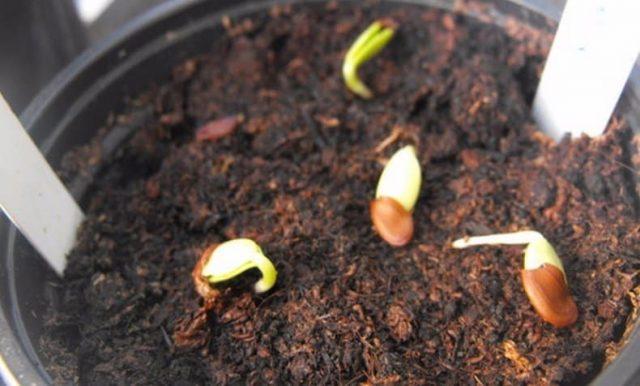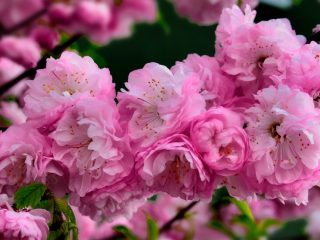Content
A photo and description of Albizia, as well as its varietal diversity, gives gardeners an idea of this pretty plant. It belongs to the Mimosa family, has the form of a small tree or shrub, and is suitable for growing in tropical or subtropical climates. Many, while on vacation in southern countries, turn their attention to the crop and wonder how to plant it on their site.

Lace foliage and pretty albizia blooms have made the plant popular among gardeners
Description and photo of Albizia
Albizia is a striking representative of deciduous acacia, found in open ground in areas with warm and mild winters. In nature, the plant is a powerful shrub or tree with dense branching, the height of which can reach 10 m, and the lush openwork crown spreads up to 7 m in diameter.The trunk of the crop is straight, up to 0.4 m thick, covered with gray bark with a finely scaly surface. The leaf blades are complex, green or bluish-violet in color, about 20 cm long. They consist of oppositely located small leaves in the amount of 15 to 30 pieces, which fold and droop when it gets dark, and open in the morning. The root system of Albizia is superficial, well developed, with numerous long shoots.
In May-June, the crop is covered with paniculate inflorescences in the form of spikes, strewn with numerous thin stamens of a purple hue. The flowers are most often white, pink, light yellow or cream. They are bisexual, have a pronounced sweet aroma, and attract much attention from bees. After falling, greenish-brown fruits in the form of long (up to 18 cm) pods are formed in place of the inflorescences. Inside them are collected beans (seeds) up to 1 cm in diameter.
In favorable conditions, in warm weather and with sufficient sunlight, the crop grows quite quickly. Temperature reduction can withstand a maximum of -15 °C. In colder winters, such as in the middle zone, Albizia dies.
In addition to growing albizia in open ground, it is also planted at home. This makes it possible to cultivate shrubs in cold regions. In the room the plant grows up to 150 cm in height, and with the highest quality care in the winter garden - up to 200 cm.When growing albitia in the Moscow region or the Volga region in the summer, it can be taken outside and kept in the shade of trees. In winter, provide the crop with peace and put it in a cool room with a temperature of about +10 ° C.

When growing albizia using bonsai technology, it has modest dimensions - from 30 cm
Where does Albizia grow?
Several regions are considered to be the birthplace of the culture, including Iran, Japan, Hindustan, Turkey, Azerbaijan, Thailand, and the territory of southern China. In Russia, albizia can only be grown on the Black Sea coast.

Due to its high decorative qualities, the plant is often found in greenhouses.
Albizia varieties
Albizia comes in several varieties. Almost all of them are popular in landscape design. Among the most common plant varieties are those presented below.
Lenkoranskaya
Lankaran Albizia Pompadour (Julibrissin Pompadour) due to its fluffy inflorescences received a second name - silk acacia. The plant is powerful and tall, with a spreading crown, covered with openwork leaves, which are bright green on the outside and lighter on the inside. The fragrant inflorescences of the culture are large, with a bunch of pink, red or cream stamens. The budding period occurs in June-July, and under ideal conditions lasts until September.

Some subspecies of Lankaran albizia are covered with purple leaves
Bunch-flowered
The bunch-flowered variety (lophantha) is characterized by its compact size. The height of the plant does not exceed 4 m. The inflorescences of the crop are spike-shaped, not large (8 cm), yellow or cream in color.The budding period of the plant lasts about three months, from the end of April, beginning of May.

Bunch-flowered albizia originated in Australia
Adobe
Albizia Saman is a large voluminous tree. The crown of the plant has an umbrella shape, it is spreading and powerful, covered with bright leaves with a wide blade. The inflorescences of a variety of red or deep pink color with the aroma of violets.

The height of the Saman variety can reach up to 20 m
Growing albizia from seeds at home
Planting and caring for Albizia at home cannot be called very simple. The crop is quite demanding in terms of compliance with the basic rules of agricultural technology; it requires constant maintenance of a certain temperature, replanting, and frequent moistening. Flower growers are not always able to get the desired result from this plant.
Albizia planting
At home, the crop is planted at the end of February, beginning of March, in a small container. Before this, the seeds are soaked for 24 hours in hot water and treated with growth stimulants. It is best to plant Albizia immediately in a ceramic pot filled with a damp mixture consisting of equal parts of turf and leaf soil, ¼ volume of sand and peat.
It is allowed to sow in plastic cups and then replant. Seeds should be planted to a depth of no more than 1 cm, watered, covered with foil and placed on a windowsill with diffused lighting. Albizia plantings should be opened daily for ventilation and moistened as the top layer of soil dries. In case of insufficient lighting, organize additional illumination of the crop with special lamps.After the seedlings have germinated, remove the cover and replant the sprouts if necessary.

Germinated seeds are transplanted into open ground only after a year.
Temperature and lighting
In order for Albizia to grow and develop well at home, it is important for it to create a favorable atmosphere for this. The place for the plant is chosen in the southwestern or southern part of the room with diffused light, where its contact with direct sunlight will be minimal. In case of insufficient lighting, the albizia is additionally illuminated.
The optimal temperature for comfortable growth of the crop is considered to be the range from +22 to +27 °C. Although, with a sufficient amount of moisture, the plant can develop normally even at a thermometer reading of +33 ° C, but without sudden changes.

Constant contact with ultraviolet radiation adversely affects the crop
Watering
Albizia loves water and needs regular watering. It is recommended to moisten the plant at least twice a week. To do this, it is best to use melted or settled water at room temperature.
Top dressing
Albizia begins to experience nutrient deficiency a year after planting. It is advisable to fertilize the plant once a month throughout the growing season. To do this, you can use complex preparations for flowering crops or organic substances in the form of humus.
Transfer
Closer to spring, Albizia, which grows in a pot, is recommended to be replanted once a year until it is four years old into a container with a diameter 3 cm larger than the previous one.Further, it is enough to carry out the procedure once every three years. Containers should first be disinfected with potassium permanganate. Use fresh soil. During work, you should use the transfer method, after which the plant should be watered with warm, settled water.
Albizia pruning
It is recommended to prune the plant in early spring, before flowering begins. Dry, old and unhealthy branches, as well as thickening shoots, must be removed. Some gardeners postpone this procedure until after flowering.
Growing albizia in open ground
Albizia can also be grown from seeds in open ground. To do this, select a lighted, but protected from direct sun, windless area. It is preferable if the soil is loose, light, and neutral in acidity. Sandstone or loam is best suited for the crop, but it is recommended to avoid clayey and acidified soil.
Plants begin to be planted in May, when the soil temperature is +15 °C and above. Before starting the procedure, dig a shallow hole, place a layer of small stones on the bottom, sprinkle with soil, place the pre-soaked swollen seed to a depth of 3-4 cm, and water. Next, the plant is regularly moistened, fertilized once a year, and mulched with peat or sawdust for the winter.

When preparing for winter, the crown of a young albizia is covered with cardboard or wrapped in thin foam rubber.
Diseases and pests
Albizia has good immunity. If cultivation is carried out in compliance with agrotechnical rules, it is rarely subject to diseases and pest attacks.But, despite this, it is recommended to treat the plant with insecticides 1-2 times per season for preventive purposes. In spring, if a crop becomes infected with a fungal infection, it should be sprayed with any fungicide.
Reproduction methods
Albizia can be propagated in several ways:
- Seeds. The method is labor-intensive, time-consuming, and requires stratification over two months. Suitable for growing crops both in open ground and indoors. It sprouts no earlier than a month after planting.
- Cuttings. This involves planting plant shoots in prepared soil. To do this, use the tops of branches older than a year, about 15 cm long. Propagation of albizia by cuttings is considered the fastest and easiest way.
- Root shoots. The cultivation method is only suitable for garden shrubs. When new shoots appear near the plant, they are simply dug up and transplanted to a new location.

Ready-made young Albizia seedlings can be purchased at specialized garden stores
Conclusion
A photo and description of Albizia proves that the plant is decorative and can fit perfectly into the landscape of any site. Gardeners often plant it as a decoration for the local area. At home, cultivation of the crop is carried out to give the interior a special zest. It is worth noting that the Lankaran albizia variety is used for medicinal purposes, as it has beneficial properties for the human body.
Reviews about growing albizia








